Media placements are the golden tickets of public relations. They offer your brand a spotlight in publications and online platforms that your target audience trust and frequent.
Whether you're doing PR for a startup looking to make its first splash or for an established company aiming to stay relevant, media coverage is a must. It may provide a significant boost to your visibility, credibility, and, ultimately, your bottom line.
In this article, you will find a comprehensive guide to getting into significant media outlets and finding your bliss.
Wondering how to find the right journalists and media outlets? Check out the Prowly Media Database.
- What are media placements and why do you need them?
- 5 benefits of getting quality media placements
- How do you create a media placement strategy?
- FAQ
What are media placements and why do you need them?
According to the definition of media placements:
Media placements involve getting content published or featured in reputable media sources. This means news websites, TV shows, podcasts, and social media platforms.
Media placement vs. ad placement vs. product placement
Media placement is about positioning content strategically and creating ads across various media channels. All to reach your target audiences effectively. If you need to, you can reach out to a media placement agency to get some assistance.
Ad placement refers to the specific location and timing of advertisements within chosen mediums, such as a particular TV time slot or Facebook Ad.
Product placement, on the other hand, integrates branded products or services seamlessly into entertainment content. We mean movies, TV shows, or video games. It is, from this list, the most subtle form of advertising.
The purpose of media placements
The main gain in media placements is that various channels can bring your brand a diverse range of benefits.
What is a traditional media placement?
Traditional media channels include:
- TV ads
- radio ads
- newspaper ads
- outdoor advertising (billboards, transit ads)
➕ Benefits:
With such a placement in marketing, you reach a wider target (geographically and demographically speaking). Moreover, traditional media outlets are often considered more trustworthy, so you can gain credibility.
What is a digital media placement?
Digital media placements involve selecting and purchasing ad placements on digital channels, such as websites or apps. It is a crucial part of media planning and media buying.
Digital media channels include:
- Video ads
- Mobile app ads
- Digital out-of-home (DOOH) ads
Bidding types:
- Search engine marketing (SEM)
- Display and pay-per-click (PPC) ads
- Social media ads
➕ Benefits:
Whether using RTB, programmatic buying or both, strategic digital media placement ensures that ads reach the right audience at the right time.
5 benefits of getting quality media placements
Media planning and placement should be carefully considered to bring your brand the benefits you want. What are the multimedia placement benefits you can choose from? Below you can find some examples.
#1 Enhanced credibility and trust
Media placements significantly boost brand credibility and trust by leveraging third-party validation from reputable outlets. This can also help overcome consumer skepticism.
Moreover, if you use a strategic media placement and take care of a consistent presence in a trusted media outlet, your brand’s reputation will begin rising over time. This will give you a positive image that resonates with your target audience. And effectively builds lasting trust and credibility.
#2 Improved SEO and visibility
High-quality backlinks are a gem when it comes to increasing brand awareness and enhancing credibility across the web.
Digital media placement exposes your brand to a wider audience. Also, it signals search engines that your website is authoritative and trustworthy. As a result, your brand can reach higher SERP positions and gain more organic traffic.
By strategically leveraging media placements as part of a comprehensive SEO strategy, businesses can effectively improve their online visibility and reach their target audience more effectively.
The best part? You can easily monitor media placements and backlinks with Prowly's media monitoring. And then you can add it straight to your report with just a few clicks - just like in the screenshot below. 👇🏼
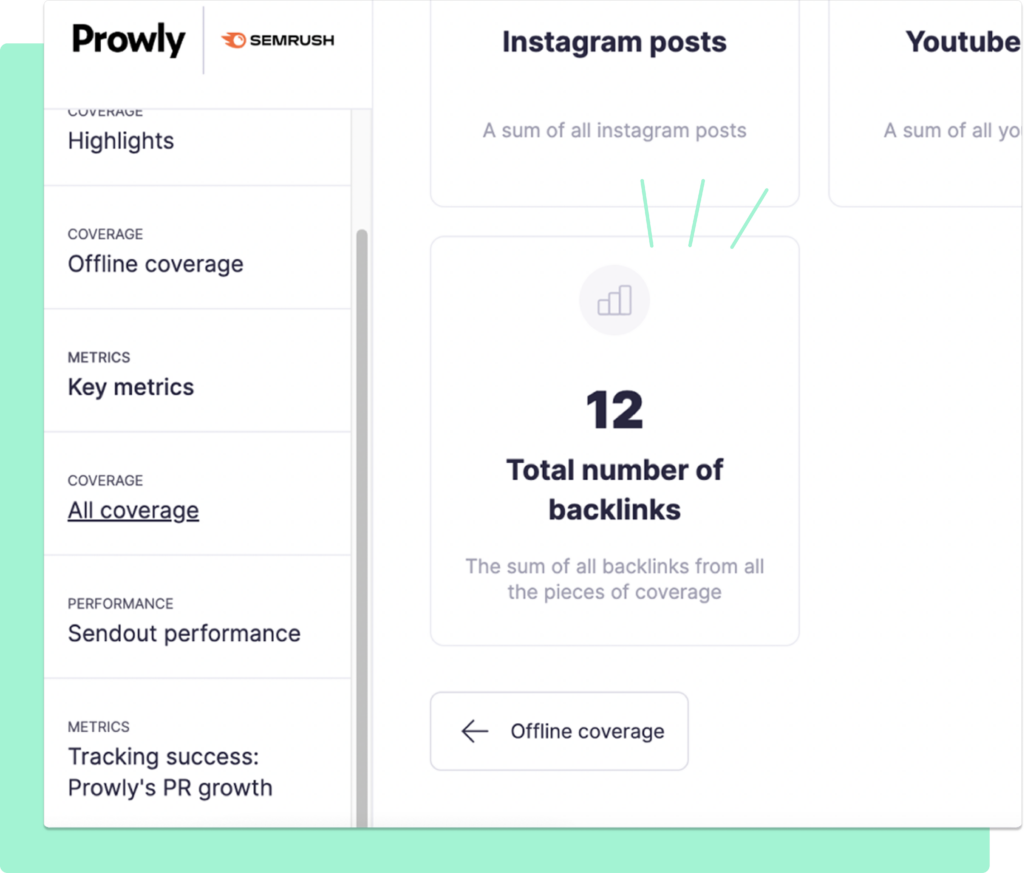
#3 Lead generation and sales growth
Creative media placements can be a game-changer for generating leads and boosting sales. By getting your brand featured in the right media outlets, you can increase your visibility and credibility with potential clients and consumers.
This means new customers as well as building trust, making them more likely to connect with your business.
To get featured in the media also means an opportunity to show off your expertise, highlight what makes you special, and provide social proof. And move leads through the sales funnel. A strategic digital media placement may provide great support at each stage of your sales process.
#4 Broadened network opportunities
When your business is featured in reputable media outlets, it attracts not only potential customers but also industry pros and potential collaborators. A well-designed and thoughtful PR placement may be a game changer for your image.
By using creative media placements you can showcase your expertise and provide social proof. Which may present you as a trustworthy collaborator/partner. Needless to say, the more visible you are thanks to earned media placements, the easier it is for like-minded professionals to find and connect with you.
#5 Content amplification
Media placement and content amplification work hand in hand to maximize the impact of your content strategy. When you get featured in media outlets, you gain credibility and reach a broader audience.
It’s a great way to kick start the spread of the word through your own channels. Share these media features on social media, your website, or even in newsletters. Just to reach even more people and keep the buzz alive.
💡 This not only increases your content's visibility but also adds credibility since it comes from trusted sources. By combining digital media placements with smart content sharing, you can create a powerful cycle that boosts brand engagement, drives traffic, and strengthens your brand’s authority in your industry.
How do you create a media placement strategy?
Before diving into the intricacies of creating a media placement strategy, it's crucial to understand the foundation upon which successful PR campaigns are built.
At the heart of this foundation lies an enriched media database, a powerful tool that provides PR professionals with comprehensive information about journalists, publications, media outlets, and how to get in touch with them.
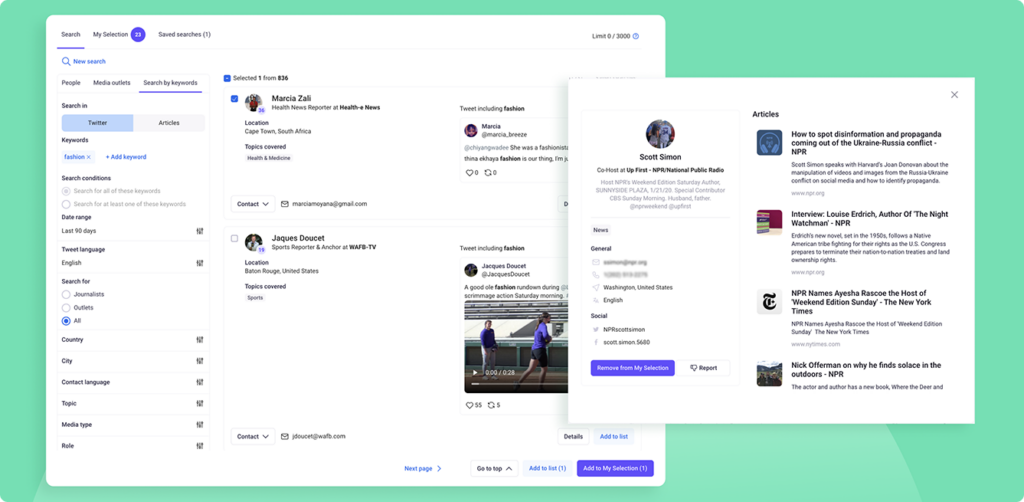
A partnership with Semrush provides data about outlet audiences and traffic that is not available elsewhere.
#1 Define clear objectives
Start with setting your goals and establish what you want to achieve. Do you want to increase awareness of your brand, its equity, or focus on AVE?
The objectives you set out to achieve determine your whole journey.
💡 Your goals and KPIs need tools for media measurement. Here you can dive into the topic of PR campaign measurements and conclude which ones would be the best fit for you.
#2 Conduct in-depth audience research
Learn all about your target audience and discover the best ways to reach them.
Identify your target audience's demographics, interests, behaviors, and media consumption habits. With this in hand you can determine their preferred media outlets and formats, like video or podcasts.
From there you will be able to create a list of potential names of channels, creators, etc. that you should connect with.
#3 Identify and analyze media outlets with data-driven outreach
This step is all about searching and planning your earned media placements.
But first, you need to focus on choosing the best journalists and creators. To do so, you should understand their interests, writing styles, and recent articles.
Tailor your pitches to align with their preferences and editorial focus. Moreover, try to create meaningful relations by researching actionable insights and data about the journalists and outlets.
Your goal is to find a way to connect your brand or product with the needs of particular journalists. And, of course, their audience. All of these should be put into a personalized email.
If you are wondering how to master this process and thus earn your media placement, Prowly is your answer. Its robust media database backed by a personal AI assistant will help you craft the best pitching strategy and personalization.
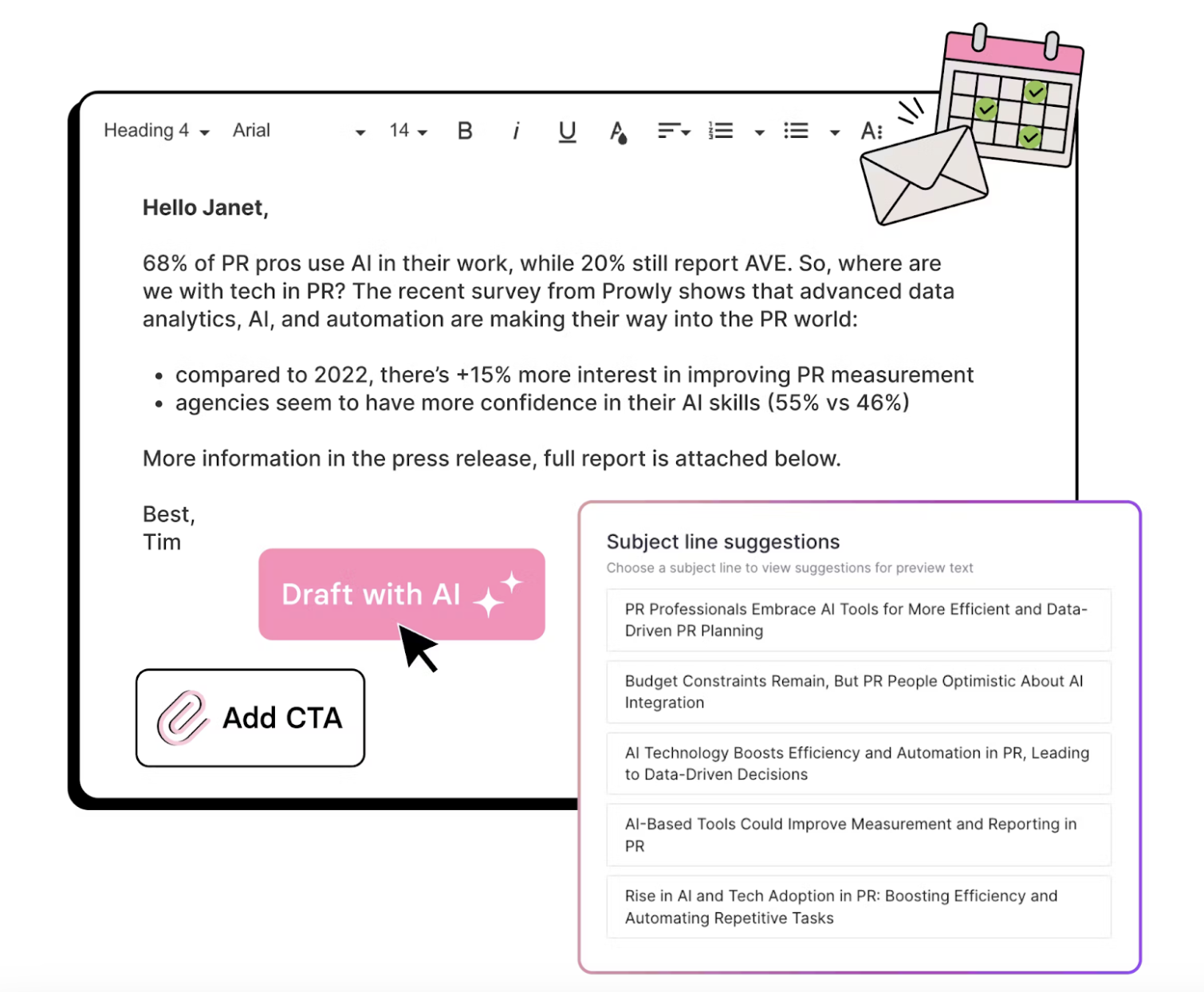
It's not just that Prowly has over 1 million contacts in their database; it's about the unique ability to dig into it.
Now you can go deeper than simply filtering journalists by the topics they cover – and that's where the real fun begins.
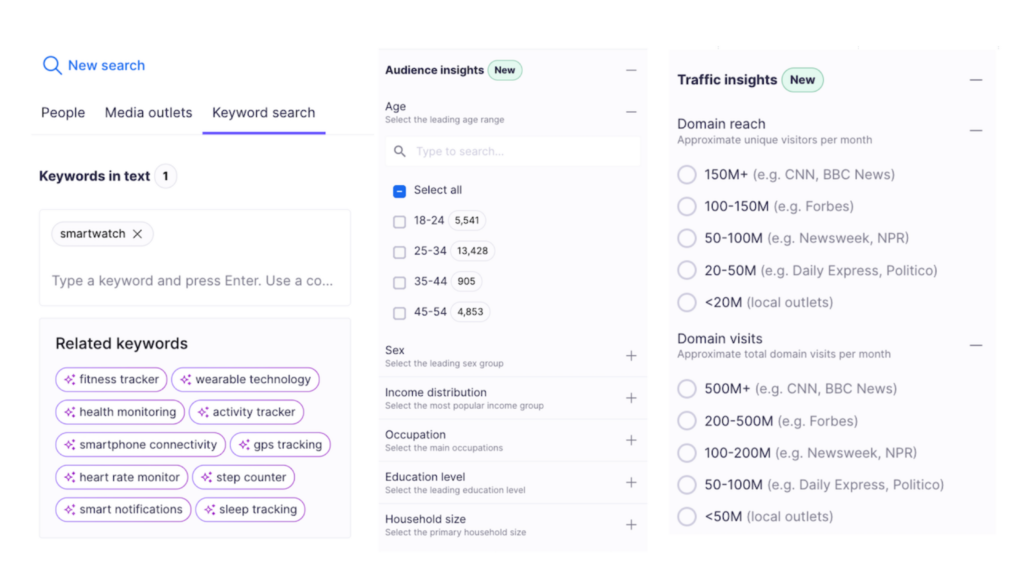
Data-driven outreach with Prowly
Before you had to filter the results by choosing e.g. location “USA” and topic “Technology”.
Result? 2881 contacts who have ever written about anything related to technology, to check one by one, click into “Details” of each person, browse through all their articles, browse through all their tweets.
Not anymore.
Now AI suggests new, relevant keywords that might also be interesting for journalists in the keyword search tab. It’s like having a brainstorming buddy, helping you come up with pitching angles and identifying journalists who might be interested in this topic.
Go to the “Keyword Search” tab and follow AI suggestions:
1️⃣ Start with your main keyword (product category), such as “smartwatch.”
Then, follow AI suggestions for related keywords and choose those that fit your story angle (fitness or health). Alternatively, you can be inspired by keyword ideas to give a twist to your pitch.
2️⃣ Narrow down your search.
Check articles or tweets, or both; filter by the last week or last month, only from online media outlets in the USA, or only those posted on blogs.
3️⃣ You can also see the publishing frequency, showing how many times a particular journalist has published an article containing your keyword.
Result?
A short list of journalists who have recently written about a specific topic, with easily accessible recent articles in the results for quick scanning.
Evaluate outlets & create a media list
Once you've noted your target audience, compile a comprehensive list of relevant media outlets, and creators.
💡 Pro tip: Take a peek into your competitor's actions. Check out where they get featured in the media.
After creating such a list you determine your top media outlets. And do not forget to update this list any time a hot new name shows up in the industry.
#4 Develop compelling story angles
It’s time for some action. Once you create your digital media placement list, you should develop a story that could catch anyone's attention.
Set a UVP ( Unique Value Proposition) and highlight what sets your brand apart. Why should they choose you?
What is more, focus on ensuring that your stories are timely, relevant, and provide value to your audience.
Last but not least, prepare several story angles to appeal to different types of media outlets and niches e.g., business, lifestyle, tech, etc.
#5 Create a robust media kit
During this step, content is king. First, make sure you’ve created high-quality content that will bring value to your audience. Then, focus on collecting it into a media kit.
What to include?
Try materials such as press releases, HD images, product info, and previous media coverage. Once you create it, make it accessible. Preferably in a visible place on your website and keep updating its content.
#6 Build and nurture relationships
When it comes to PR, relationships are key. So not only data-driven decisions can lead you to success. People are also a crucial factor.
So when pitching or casually keeping up to date with your favorite creators, make sure your messages are considerate and personalized. Don't trust this task to AI alone.
#7 Craft targeted pitches
Personalize your pitches. Craft them from the heart. If you need some assistance with grabbing journalists's attention by recalling, eg. their previous work, Prowly’s AI Assistance is here to help. With two clicks it can give you a full list of their work. But remember to add that human touch!
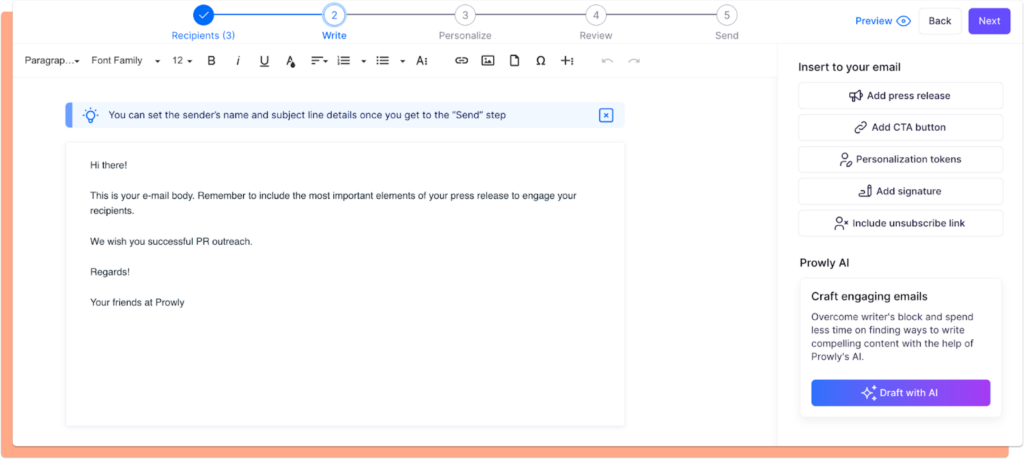
Sometimes, you need to pop up in their minds two or three times before they reach back. So drafting a polite follow-up should be your bread and butter. With Prowly, you can create such emails in seconds. Helpful, isn’t it?
#8 Utilize advanced tools and platforms
Digital media placement is all about channels and outlets. So choose them wisely and monitor their work.
Hopefully, you have some tools to get it done. We mean tools like Meltwater, Cision, or Prowly. Check out our article for the pros and cons of each.
Moreover, you should leverage comprehensive media databases to identify and segment media contacts to keep all the most important data at hand.
FAQ: media placements
💬 How to get a media placement?
First, define your target and goals. Then search for your preferred media outlets, reach out to their creators, and deliver a story worth sharing.
💬 What is a placement in advertising?
Placement in advertising refers to the strategic positioning of promotional content across specific media channels. It aims to reach the intended target audience effectively.
Looking for some help with media placements?
Crafting your approach to achieving PR placements or creative media placements should be your focus if you want to spread the word about your brand. It can be as subtle and gentle as thought thanks to product placement or more direct messaging via ads.
No matter the channels you choose, remember to follow our guide and get earned media placement that will bring you a full range of benefits.
Looking for some help with media placements? Choose Prowly to help you get the best media outlets and draft a masterpiece pitch!
